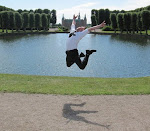 |
| Denmark from satellite view |
Denmark has an average of 121 days per year with precipitation, receiving an average total of 712 mm per year; Autumn is the wettest season and Spring the driest. The driest Spring ever recorded in Denmark happened in 1974 with a mere 46 mm of precipitation and the wettest Autumn was 1967 with 327 mm of precipitation. The most precipitation ever recorded over a 24 hour period was 168.9 mm on July 8-9 1931.
Due to the North Sea coastline the western part of Denmark usually gets the most wind (called a bit of fresh air by the locals there). The highest wind speed on land was recorded on Dec 3 1999 with 137 km/h (85.13 mph) wind speed averages and gusts of 185 km/h (114.95 mph). On the same day at sea (an oil-platform in the North Sea located at 55°30' N 05°00' E) the average wind speeds reached 185 km/h (114.95 mph) with gusts of 213 km/h (132.35 mph).
Because of Denmark's northern location (Denmark shares latitude with the Alaskan panhandle), there's a great deal of difference between the length of a day, depending on the season. There are short days during the winter with sunrise coming around 8:45 AM and sunset 3:45 PM and long summer days with sunrise at 4:30 AM and sunset at 10 PM. Summer days will seem even shorter as the light stays long after sunset and lights the sky long before sunrise. Winter days will accordingly seem even shorter.
Christmas (Danish: jul), is celebrated on Christmas Eve, 24 December. The celebration for the longest day is known in Denmark as Skt. Hans Aften (St. John's evening). Celebrations of Midsummer have taken place since pre-Christian times.
Sources for the data used:
http://en.wikipedia.org/wiki/Denmark
http://www.dmi.dk/dmi/index/
http://www.dmi.dk/dmi/index/danmark/meteorologiske_ekstremer_i_danmark.htm







No comments:
Post a Comment